Renault
Sport
Clio V6 Mk1
 Here
comes the long-awaited Clio V6, officially described as the work of
Renault
Sport whose first attempt was the lightning-quick Clio 2.0 16V but in
fact
it is more a brainchild of British consultant TWR, the company brought
us cars like Jaguar XJR-15, XJ-220, Aston Martin DB7, Volvo C70, Saab
9-3
Viggen and Holden HSV. The Clio V6 is also being assembled in TWR’s
Uddevalla
plant in Sweden which is currently building C70 for Volvo. However, the
basic Clio body shell, many components and the whole Renault
Sport-tuned
V6 are shipped directly from France. Here
comes the long-awaited Clio V6, officially described as the work of
Renault
Sport whose first attempt was the lightning-quick Clio 2.0 16V but in
fact
it is more a brainchild of British consultant TWR, the company brought
us cars like Jaguar XJR-15, XJ-220, Aston Martin DB7, Volvo C70, Saab
9-3
Viggen and Holden HSV. The Clio V6 is also being assembled in TWR’s
Uddevalla
plant in Sweden which is currently building C70 for Volvo. However, the
basic Clio body shell, many components and the whole Renault
Sport-tuned
V6 are shipped directly from France.
We have had high
expectation
for this car since its show appearance some 2 years ago, mainly because
of its stunning look. Wide, sportive and purposeful but simultaneously
elegant and subtle. Can’t imagine it is based on Clio. Who did this
magic
? I don’t know but believe that Ian Callum, the design chief in TWR
then
or the one who designed Aston Martin’s Vanquish (previously known as
Project
Vantage) or the current design boss of Jaguar, has an important hand in
its shaping. Such a long description just serve to bring you more faith
in its design.
Mechanically,
it’s quite
interesting. First of all, it is mid-engined. Yes, a mid-engined
Supermini
! well, perhaps Ultramini. Not ground-breaking if you notice that in
AutoZine’s
Strange Car archive there were already a Renault R5 Turbo and Turbo 2
stunned
the world in 1981 and 84 respectively with their mid-engined layout.
The
new Clio V6 can barely said as the company’s third attempt.
Another
interesting thing
must be the engine - a V6 displacing a full 3-litre (well, maybe 2.9,
my
lad). You won’t be surprised as well if you know it is actually the
so-called
"French National V6" (I know, this name is purely my creation) which is
developed and built jointly by Renault and PSA, supplying Peugeot 406,
607, Citroen Xantia and Renault Laguna. It is variable timed for intake
valves, so it is the newer version first appeared in Peugeot 607. While
the mass production saloon develops 210 horsepower as well as lbft, the
Renault Sport tuned version pumps out 230 hp and 220 lbft, thanks to
the
increase of compression ratio to 11.4 : 1 by means of new pistons,
reworked
intake ports and exhaust, plus lighter flywheel to favour throttle
response
instead of refinement. As a result, rev limit has been lifted by 500
rpm
to 7100 rpm.
Outstanding
figures? not
exactly, but good enough for use in the Clio. It is just disappointing
that it didn’t turn out to be 250hp as promised earlier, so rumours say
now Lotus has to find a more powerful alternative for its forthcoming
M250
sports car.
However, the
Renault Sport
unit is given with a unique Six-speed manual gearbox unfound in other
cars
using the same French National V6, with the exclusion of Renault
Avantime.
This should give it the much-needed acceleration to fend off the
internal
competition from Clio 2.0 16V (which is very cheap). Why ? because the
Clio V6 carries some 1340 kg of kerb weight compare with its sister’s
1070
kg, canceling most of the advantage in power. Launch in straight line,
the V6 is estimated to reach 60 mph in 6.1 sec (half a tick quicker
than
the 2.0) and then 100 mph in 16.5 sec. It can top 147 mph. All these
figures
say the car is currently the quickest hot hatch, beating Audi S3. (Wait
a moment, is it really a hot hatch ? or simply a mid-engined 2-seat
sports
car ?)
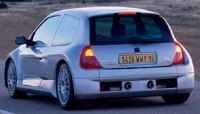 Anyway,
you won’t feel the car as explosive as many turbocharged rivals
including
Lancer Evo or Impreza STi, although it does feel quicker than the
regular
WRX. It differs from these cars by the way it performs - the big
variable-valve
timed V6 is smooth, linear and flexible for overtaking. Moreover, it
sings
a six-cylinder song beautifully, especially the hatch-style cabin
actually
amplify engine sound from the back to the driver’s ear. Anyway,
you won’t feel the car as explosive as many turbocharged rivals
including
Lancer Evo or Impreza STi, although it does feel quicker than the
regular
WRX. It differs from these cars by the way it performs - the big
variable-valve
timed V6 is smooth, linear and flexible for overtaking. Moreover, it
sings
a six-cylinder song beautifully, especially the hatch-style cabin
actually
amplify engine sound from the back to the driver’s ear.
Excluding the
sound and the
lack of rear seats, the cabin feels as if the Clio 2.0, or to lesser
extent
any bread-and-butter Clio. Same supportive seats and metallic finish to
panels / pedals as the 2.0, same cheap feeling. Very practical,
however.
Superb visibility, good driving position, vast of head and leg room.
There’s
a small boot up front and space for a pair of mid-size suit case just
behind
seats.
Now comes the
chassis, which
is mainly TWR’s job. They widened the tracks by a massive 110 mm up
front
and 138 mm at the rear, drop the ride height by 66 mm and increase
wheelbase
slightly by 38 mm. The body panels that covers the extended sections,
such
as fenders and skirts, plus the new doors are made of composite fiber.
The transverse drivetrain is mounted on a lattice of structural members
take place in what used to be the rear seats. Instead of the original,
simple & incapable torsion beam rear suspensions, there is a new
multi-link
setup to handle the extra requirement. Front suspension, although still
a MacPherson strut setup, is also new and it is now mounted on new
sub-frame
which include a big cross member for higher rigidity (crucial for the
widened
track)
The real question
is whether
the mid-engined layout really benefit handling. Look at the spec. and
you’ll
find many things actually conflicting with laws of physics - the
wheelbase
of the car is just 2510 mm, with the rear wheels placing right in front
of the tail with actually no rear overhang, and then the heavy V6
(although
all-alloy, it’s still a 3-litre V6) with transmission is located right
on the rear axle, and is mounted quite high. The result is a heavy
rear-biased
weight distribution, a less-than perfect polar moment of inertia and a
high center of gravity. Someone even said it is a hatchback 911 !
Therefore TWR had
to build
a lot of understeer into the suspensions. Drive the car in straight
line,
it feels superbly stable. Ride is firm for low speed bump but better at
speed. The cable-connected six-speed box shifts crisply yet light.
Enter
a series of corners at moderate speed, it still feels very good, thanks
to the sweet steering which is full of communication. There’s strong
grip
coming from the 17-inch wheels with 235 width at the rear especially,
but
the rear end rolls more than expected, a thing deliberately done by
TWR.
Press hard to the extent that exceed its cornering limit and you’ll
back
off the throttle, then you’ll be suddenly stunned by the severe
lift-off
oversteer that dominate the whole picture and eventually lead to a
spin.
OK in racing circuit but never do it at your country roads. Really a
hatchback
911. And I am meaning the 911 of at least 10 years ago.
If you survive,
you’ll learn
how to drive it: never try its limit. This is a car requires respect.
The
best way to drive it is slow in fast out, which is easy and enjoyable
to
do as the huge brakes are strong, the long travel of throttle pedal
easily
controls the right amount of torque needed and the superb steering
tells
you exactly how much grip left. This car is really strange: if not
exceeding
its limit, it is sweet to drive; once exceeded, it’ll be a nightmare.
Despite of its
flaws, the
car is likely to be a hot sale because Renault will build only 3,000
cars.
With this attractive look, special mechanical design and rarity, few
people
will find the £26K price tag too expensive.
|
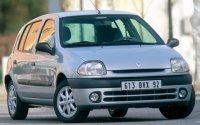 The
main target of the new Clio is cost reduction. In order to prepare for
a throat-cutting competition expected in Europe, Renault builds the new
car around the old platform. In addition, production simplicity was
taken
into account since the design stage. Reduction of manufacturing cost is
implemented by the following points :
The
main target of the new Clio is cost reduction. In order to prepare for
a throat-cutting competition expected in Europe, Renault builds the new
car around the old platform. In addition, production simplicity was
taken
into account since the design stage. Reduction of manufacturing cost is
implemented by the following points :
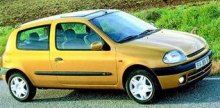 When
comes to
handling, Autocar
magazine found this is not Clio's strength any more. Engineers did
improve
noise, vibration and ride, but the soft spring leads to more body roll,
while steering lacks sharpness and feel. Like Golf IV, the new Clio
pursuit
maturity over dynamic excitement.
When
comes to
handling, Autocar
magazine found this is not Clio's strength any more. Engineers did
improve
noise, vibration and ride, but the soft spring leads to more body roll,
while steering lacks sharpness and feel. Like Golf IV, the new Clio
pursuit
maturity over dynamic excitement. 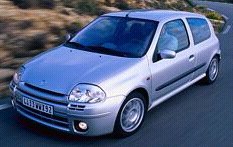 Renault
Sport, once the F1 ace dominating half of the 90s. Renault Clio, a
boring-to-handle
hatchback. How could they be linked together in the creation of Renault
Sport Clio 2.0 16v ? When Renault officially pulled out from F1 in the
end of 1997, its road cars were still employing 2-valve-per-cylinder
engines.
Concentrating resources back to production car R&D results in a
full
range of 4-valve engines today, Europe’s first direct injection
gasoline
engine and a few sporting models, such as the mid-engined Clio V6 and
this
one, Clio 2.0 RS. Both cars were developed by Renault Sport.
Renault
Sport, once the F1 ace dominating half of the 90s. Renault Clio, a
boring-to-handle
hatchback. How could they be linked together in the creation of Renault
Sport Clio 2.0 16v ? When Renault officially pulled out from F1 in the
end of 1997, its road cars were still employing 2-valve-per-cylinder
engines.
Concentrating resources back to production car R&D results in a
full
range of 4-valve engines today, Europe’s first direct injection
gasoline
engine and a few sporting models, such as the mid-engined Clio V6 and
this
one, Clio 2.0 RS. Both cars were developed by Renault Sport.
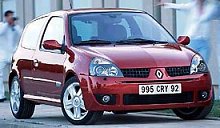 Call
it facelift is misleading. Renault claims 50% change of structural and
bodywork components, plus a new 1.2-litre 16V and two 1.5-litre turbo
diesel,
application of electric power steering, electronic throttle to cut
emission,
improved windscreen sealing to reduce NVH, completely reworked interior
and addition of safety equipment. Not just the nose job. All this
account
for £126 million. What a "facelift" !
Call
it facelift is misleading. Renault claims 50% change of structural and
bodywork components, plus a new 1.2-litre 16V and two 1.5-litre turbo
diesel,
application of electric power steering, electronic throttle to cut
emission,
improved windscreen sealing to reduce NVH, completely reworked interior
and addition of safety equipment. Not just the nose job. All this
account
for £126 million. What a "facelift" !
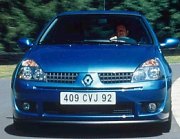 Clio
RS is what most customers want, for it is fast without sacrificing
comfort.
However, to the keenest drivers, they will prefer Clio Cup - a limited
edition built to homologate Group N rally. There are not many such
drivers
though, thus Renault Sport will produce just 2500 units.
Clio
RS is what most customers want, for it is fast without sacrificing
comfort.
However, to the keenest drivers, they will prefer Clio Cup - a limited
edition built to homologate Group N rally. There are not many such
drivers
though, thus Renault Sport will produce just 2500 units.
 Predictably,
the chassis is tuned sportier. Stiffer springs and dampers are used.
Modifications
to suspension geometry result in slightly wider tracks and lower ride
height
(well, just 3mm). Tyre size remains unchanged, but the tyres are
sportier
Continental ContiSport while the new 11-spoke alloy wheels look
definitely
smarter.
Predictably,
the chassis is tuned sportier. Stiffer springs and dampers are used.
Modifications
to suspension geometry result in slightly wider tracks and lower ride
height
(well, just 3mm). Tyre size remains unchanged, but the tyres are
sportier
Continental ContiSport while the new 11-spoke alloy wheels look
definitely
smarter. 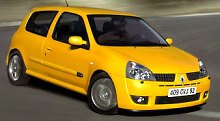 Renault
Sport Clio 2.0 RS has been proved a thorough success no matter in terms
of market reception or press comments. However, the hot Clio does not
want
to rest on its laurel. It is now evolved into an even better car, Clio
182. The new car is even faster and better to control.
Renault
Sport Clio 2.0 RS has been proved a thorough success no matter in terms
of market reception or press comments. However, the hot Clio does not
want
to rest on its laurel. It is now evolved into an even better car, Clio
182. The new car is even faster and better to control.
 Here
comes the long-awaited Clio V6, officially described as the work of
Renault
Sport whose first attempt was the lightning-quick Clio 2.0 16V but in
fact
it is more a brainchild of British consultant TWR, the company brought
us cars like Jaguar XJR-15, XJ-220, Aston Martin DB7, Volvo C70, Saab
9-3
Viggen and Holden HSV. The Clio V6 is also being assembled in TWR’s
Uddevalla
plant in Sweden which is currently building C70 for Volvo. However, the
basic Clio body shell, many components and the whole Renault
Sport-tuned
V6 are shipped directly from France.
Here
comes the long-awaited Clio V6, officially described as the work of
Renault
Sport whose first attempt was the lightning-quick Clio 2.0 16V but in
fact
it is more a brainchild of British consultant TWR, the company brought
us cars like Jaguar XJR-15, XJ-220, Aston Martin DB7, Volvo C70, Saab
9-3
Viggen and Holden HSV. The Clio V6 is also being assembled in TWR’s
Uddevalla
plant in Sweden which is currently building C70 for Volvo. However, the
basic Clio body shell, many components and the whole Renault
Sport-tuned
V6 are shipped directly from France.
 Anyway,
you won’t feel the car as explosive as many turbocharged rivals
including
Lancer Evo or Impreza STi, although it does feel quicker than the
regular
WRX. It differs from these cars by the way it performs - the big
variable-valve
timed V6 is smooth, linear and flexible for overtaking. Moreover, it
sings
a six-cylinder song beautifully, especially the hatch-style cabin
actually
amplify engine sound from the back to the driver’s ear.
Anyway,
you won’t feel the car as explosive as many turbocharged rivals
including
Lancer Evo or Impreza STi, although it does feel quicker than the
regular
WRX. It differs from these cars by the way it performs - the big
variable-valve
timed V6 is smooth, linear and flexible for overtaking. Moreover, it
sings
a six-cylinder song beautifully, especially the hatch-style cabin
actually
amplify engine sound from the back to the driver’s ear.
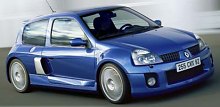 So
far, Renault sold 1630 units of the original Clio V6, failed to reach
its
target of 3000 cars. From styling and engineering point of view, it is
by all means a very desirable car, because you can’t find another car
looked
like it or constructed in the same way. However, it was also troubled
by
two weaknesses: slow and tricky to handle. Obviously, to be successful,
Clio V6 Mk2 must overcome these two hurdles.
So
far, Renault sold 1630 units of the original Clio V6, failed to reach
its
target of 3000 cars. From styling and engineering point of view, it is
by all means a very desirable car, because you can’t find another car
looked
like it or constructed in the same way. However, it was also troubled
by
two weaknesses: slow and tricky to handle. Obviously, to be successful,
Clio V6 Mk2 must overcome these two hurdles.
 As
before, the engine is basically a 2946 cc "French National" V6 with 24
valves and variable valve timing. It used to produce just 230hp, thus
left
a lot of room for improvement. Renault Sport applied some usual racing
techniques such as a camshaft with faster timing and higher lift and a
bigger intake plenum with shorter manifolds to smoothen breathing. The
result is remarkable, with 25 extra horsepower generated at 7150rpm.
This
V6 is unusually high-revving.
As
before, the engine is basically a 2946 cc "French National" V6 with 24
valves and variable valve timing. It used to produce just 230hp, thus
left
a lot of room for improvement. Renault Sport applied some usual racing
techniques such as a camshaft with faster timing and higher lift and a
bigger intake plenum with shorter manifolds to smoothen breathing. The
result is remarkable, with 25 extra horsepower generated at 7150rpm.
This
V6 is unusually high-revving.  So,
Problem One has been solved. Problem Two - tricky handling - is dealt
in
the following ways: wheelbase is lengthened by 23mm, front track is
widened
by 33mm, front castor angle is increased, rear suspensions are mounted
on a stiffer subframe. Both front and rear anti-roll bars are now
thicker
and connected via drop links to make cornering more progressively.
Springs
are set slightly stiffer. Wheels grow from 17 to 18-inch. Rear tires
are
widened from 235 to 245mm. All tires are of lower profile.
So,
Problem One has been solved. Problem Two - tricky handling - is dealt
in
the following ways: wheelbase is lengthened by 23mm, front track is
widened
by 33mm, front castor angle is increased, rear suspensions are mounted
on a stiffer subframe. Both front and rear anti-roll bars are now
thicker
and connected via drop links to make cornering more progressively.
Springs
are set slightly stiffer. Wheels grow from 17 to 18-inch. Rear tires
are
widened from 235 to 245mm. All tires are of lower profile.